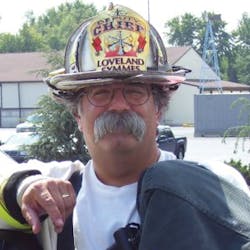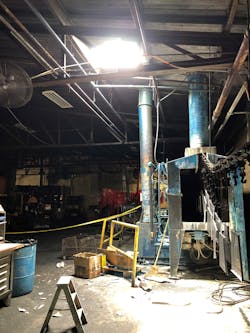I learned about this close call from a news article. Its headline indicated that the fire chief was very concerned that one of his members fell through the hole in a roof at industrial building fire. “Very concerned.” That’s how the response should be: A fire chief who gives a damn when there is a close call and who wants to minimize the likelihood that it will happen again exemplifies a critical segment of leadership.
Unfortunately, even in some of the line-of-duty critical injury and death investigations that I was a part of, there are those who would write off this type of incident as “part of the job” and would continue to do the same things over and over: leadership that for a variety of reasons refuses to understand the critical need to consider change.
Make no mistake about it—and we always will say it—this is a risky job. For firefighters to do the expected and defined job, risks must be taken. Sometimes these risks are extreme, but the calculation of that risk tells the firefighter, the company officer and the chiefs that action must be taken to make a search, a rescue, the fire attack, etc.
As we have discussed forever in this column, we must understand that there are some absolutely necessary risks, but then there are some that are the opposite of that—and some that border on stupidity. Searching a building with probable occupants? Time-proven to be necessary. Separating from your crew because you want to do your “own thing?” Time-proven to be stupidity.
In this month’s Close Calls, firefighters from The City of Dayton, TN, Fire-Rescue (DFD) responded to an industrial building fire and, while operating, experienced a mayday. A crew was sent to the roof of the building—and a member fell through the roof. Thanks to Chief Charles Suttles, Firefighter Michael Brown and the entire membership of the DFD for their contribution to this report. Their close call provides another opportunity for all of us to learn.
DFD & the fire
As I was learning about the DFD, what struck me was how they successfully protect some very significant challenges. They operate as a full-service fire, rescue and EMS combination department. In 2019, the department responded to 1,059 calls for emergency service. Emergency medical and rescue/vehicle extrication services accounted for 65 percent of that call volume.
The DFD is a combination fire department that consists of nine full-time personnel and 17 paid-on-call volunteer personnel. Current staffing levels only allow the DFD to maintain three on-duty personnel (two career and one part-time) per 24-hour shift.
The DFD places a tremendous responsibility on their limited career staff. Their first-due response area includes approximately 2,400 residences, at least 600 businesses, three elementary schools, four day care centers, 29 churches, five motels, three nursing homes, a community college and a four-year college campus (that has 16 buildings, including seven dormitories that house more than 800 students). The city’s industry includes 31 factories.
On May 12, 2020, the DFD was alerted to respond to a fire in an industrial building. The dispatch: a standard first alarm of all on-duty and all-available paid-on-call plus command. (Mutual aid is special called as determined by the incident commander [IC].)
The fire spread between the factory’s roof and ceiling, and crews were on the roof to try to open it up. However, the roof was weak, and before a ladder could be secured, a firefighter fell through. After dropping 25 feet, he landed on a concrete floor. A mayday was transmitted. Fortunately, the factory’s ductwork slowed the firefighter’s fall, and his protective gear helped to blunt the impact, so the firefighter only suffered bruising.Account from Michael Brown
I was assigned to roof operations to find the fire that progressed through the flue pipe and spread to the roof structure. While placing a roof ladder at the area of operation, a weak span of roof that I was on gave way. As my feet went through, I spread my arms in an attempt to stop myself from falling. As my arms came through, I closed my eyes. It was as if my heart stopped beating while I was falling. I remember hitting something solid before hitting the concrete. I stood up and attempted to find means of egress. With the pain in my hip and the adrenaline rush, my fight-or-flight kicked in, but I realized that I was lost. I then called a mayday for being disoriented and injured from the fall. I stumbled around for what seemed like forever before one of the interior operations crew saw me and radioed that he found me. He helped me onto a company golf cart and took me to the command post. After being transported to the emergency room and being put through a series of tests, I learned that I didn’t sustain any life-threatening injuries.
Account from Chief Charles Suttles
The fire occurred in Station 2’s district, which is located within Dayton’s industrial park. Engine 3 and Tower 1 responded from Station 2, and Engine 1 responded from Station 1.
The smoke from the fire was so very light that we had difficulty locating the fire. Via thermal imaging, we found it within the ceiling. Crews couldn’t pull the heavy corrugated metal ceiling. The ceiling was turning red, and the decision was made to open the roof.
As IC, I couldn’t see anything. The building was so large that smoke hadn’t filled to the point of showing. I only could rely on what the interior crew reported. The decision was made to go for the roof. I assigned Michael Brown and another firefighter to find a location that was near the fire to open the roof. I recall cautioning Brown to be particularly careful, given that the roof once included skylights, which were removed and covered over. Brown worked at the facility before coming to the DFD, so he knew those obvious locations. What we didn’t know was that an entire section of roof was replaced with thin, corrugated fiberglass material. That material matched the roof.
When the mayday came over the radio at 12:03 p.m., everything froze in time. Crews reported that they were looking for Brown. Once located, they gave a report of his injuries and that they were preparing to bring him out. Once he was out and I could talk to him, only then could I begin to think again. This sequence of events seemed like they took forever when, in fact, it was only two minutes from the mayday until I was talking to him at the command post. Great work from interior crew.
Firefighter Jerry Anne Howard was assigned to treat him until the ambulance arrived. Then I had to make a tough call. I noticed that the whole department was there watching out for Brown, but I had to remind them that we still might have fire to attend to, so crews were directed to focus on that.
What would we do differently? Better pre-planning. The DFD makes every effort for the entire department to annually participate in a guided tour of our larger industrial plants and those that pose significant dangers. This allows members to know every room of every such building and the dangers that they contain. Members commonly look for alterations, new dangers or other notable changes. That said, how many of us actually ask, “Have any changes been made to the roof, which could place our members in danger?” We will ask in the future.
Comments from Chief Goldfeder
Suttles refers to his personnel as his kids, indicating the level of commitment and love that he has in doing his best to take care of them. “You might be able to experience some of the feelings that I had when the mayday call came out” if you consider the matter in those terms, Suttles says. “I felt agony. I felt regret. And I just felt miserable, because I sent [Brown] to do that job, and he got hurt,” Suttles explains. “It is something we never want to experience again—but if we do, we are even better prepared to respond to it.”
With the DFD’s limited staffing, pre-planning, although essential, is a challenge.
I always feel better when I pull up to a building that I have helped pre-plan, walked through, etc., compared with when I pull up to a building that I have no details on.
Give me a pre-plan document? That’s good too.
Without pre-planning, walk-throughs and related documents, we go in blind. Anytime we can have more information versus less, the better. It’s kind of like going on a blind date: The more information, the better the outcome.
Also, don’t ignore cautiously heading to the roof during pre-planning and walk-throughs, so there aren’t any surprises when you do have a fire. These days, in addition to HVAC equipment, everything from solar panels to cellular equipment can be found on a roof.
Other important takeaways:
Roof operations. This article isn’t about roof operations, but a few reminders come to mind. When companies are assigned to the roof, gravity works against them. That might sound obvious, but it’s good to be reminded that roof operations have their inherent, but often necessary, risks. Once conditions indicate it, an experienced truck officer who uses policy/guidelines is the one to determine when crews head to the roof. Remember, the roof is a little-known place, because owners, employees, etc., don’t hang out up there—and until we have access, we can’t see what’s up there.
Size up before heading up. The Halligan tool, a pike pole, a pick/flat-headed axe, a roof hook, a rotary saw, a chainsaw and a thermal imaging camera (TIC) all are tools that you potentially will need. So, bring them. Use your TIC as soon as you gain roof-vision access, but don’t just rely on the TIC. It’s a combination of tools and skills (training) that help us to do what’s needed up there.
Watch for conditions, including smoke (color, velocity, etc.).
Staffing. Like almost all departments throughout North America, with the exception of some metropolitan departments, staffing remains a constant and critical challenge. We could spend pages and pages explaining and justifying the need for staffing, but the fact is, a community has what a community has. Often, it’s a simple math equation—“We only have so much money available”—and it becomes the challenge of the chief, labor and related advocates to help to minimize the risk of low staffing—be it career or volunteer.
Simply put, when we look at the tasks that are required, at minimum, we need to size up, establish water, stretch at least three lines (primary, secondary and backup), force entry, search, rescue, vent, supervise, rapid intervention and stage. Although so many departments are challenged with low staffing, the fire doesn’t care, and it will continue to burn, injure, kill and destroy at the same rate whether we turnout with three firefighters or 30.
Fortunately, the DFD has a group of paid-on-call firefighters as an automatic part of their first-alarm assignment. Many communities don’t have that resource. For those that have predictable low-staffing response, strong consideration should be given to a fair and equitable automatic mutual aid response. This assures that a pre-planned and adequate number of firefighters and command officers will respond to match the predictable tasks.
About the Author
Billy Goldfeder
BILLY GOLDFEDER, EFO, who is a Firehouse contributing editor, has been a firefighter since 1973 and a chief officer since 1982. He is deputy fire chief of the Loveland-Symmes Fire Department in Ohio, which is an ISO Class 1, CPSE and CAAS-accredited department. Goldfeder has served on numerous NFPA and International Association of Fire Chiefs (IAFC) committees. He is on the board of directors of the IAFC Safety, Health and Survival Section and the National Fallen Firefighters Foundation.


